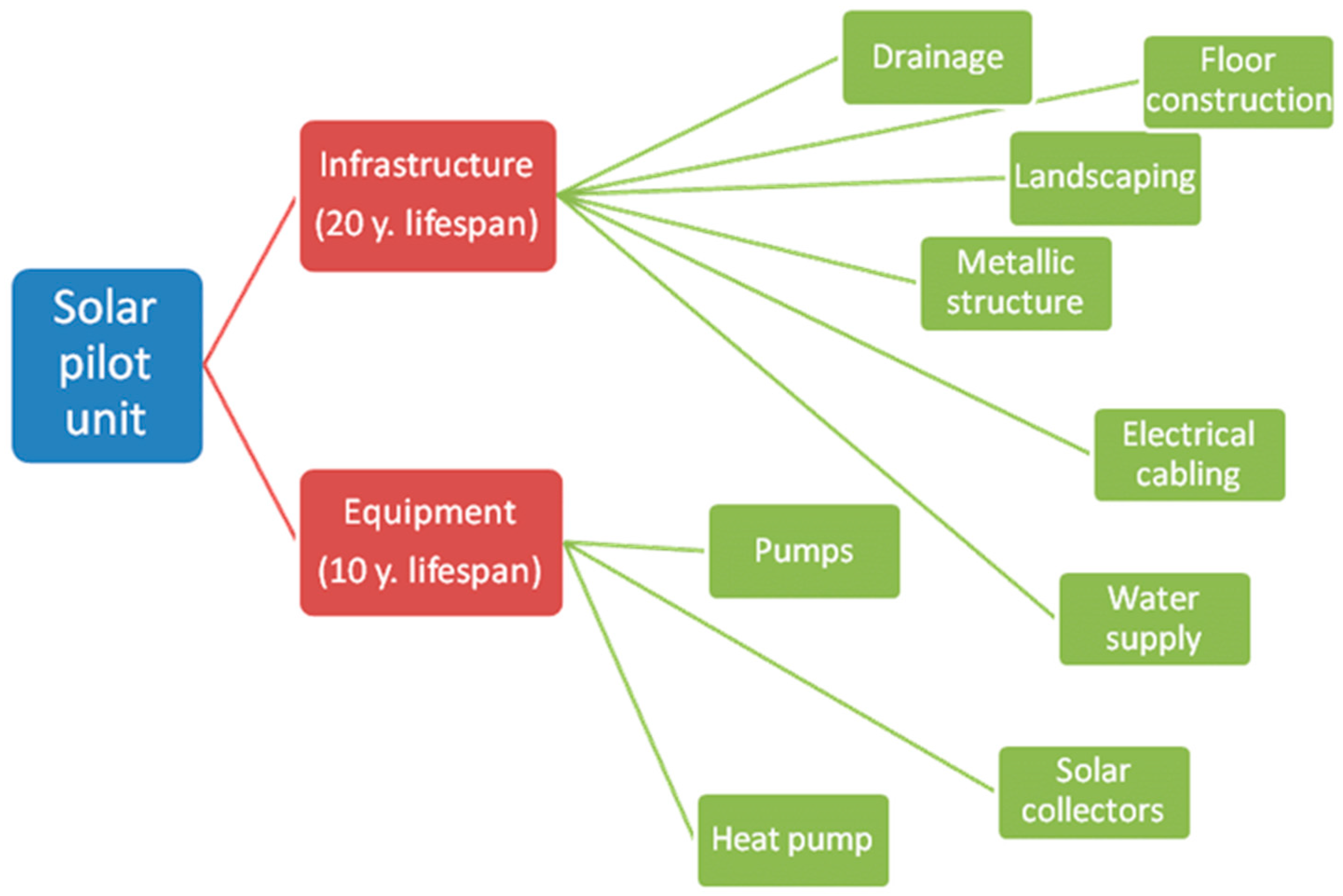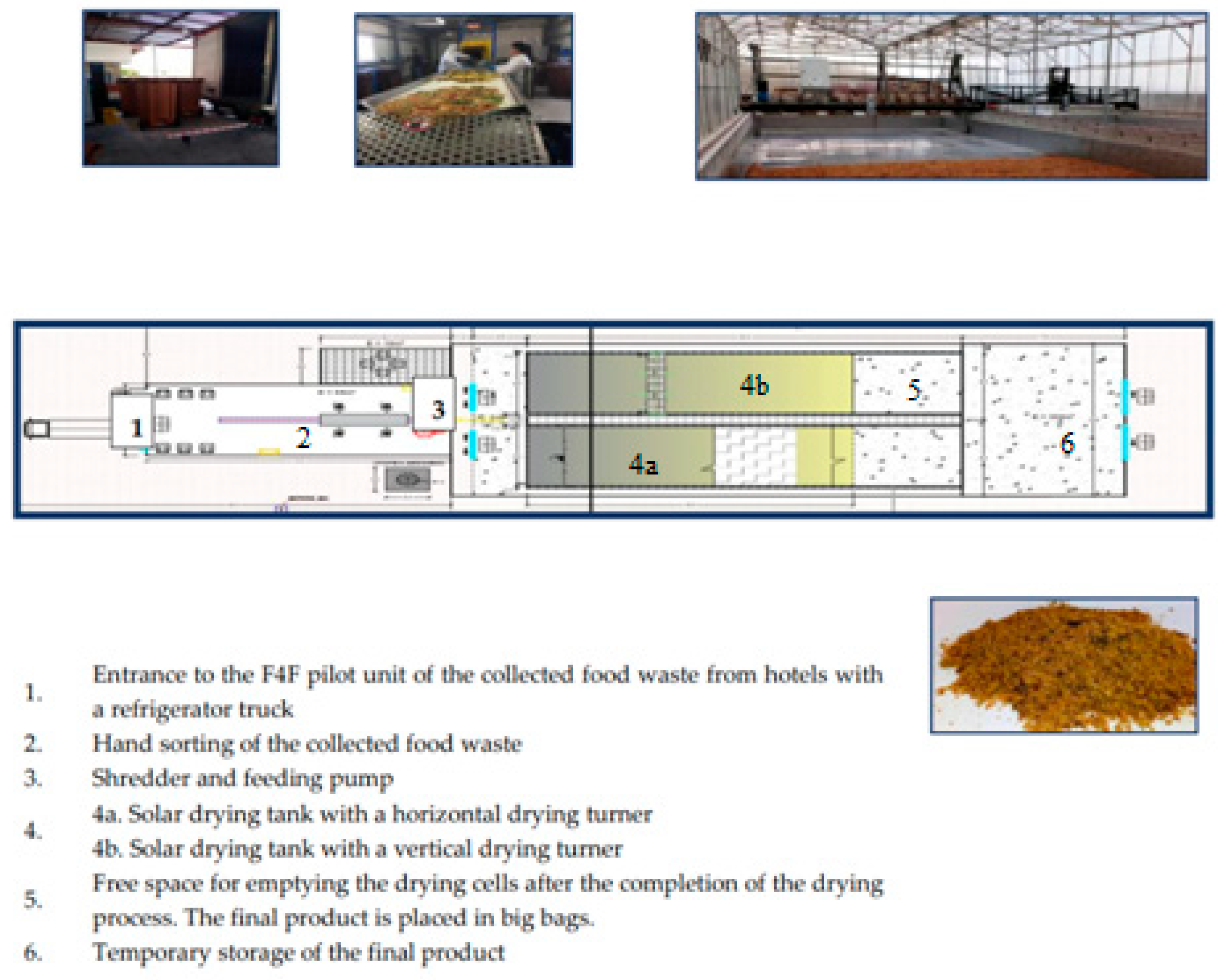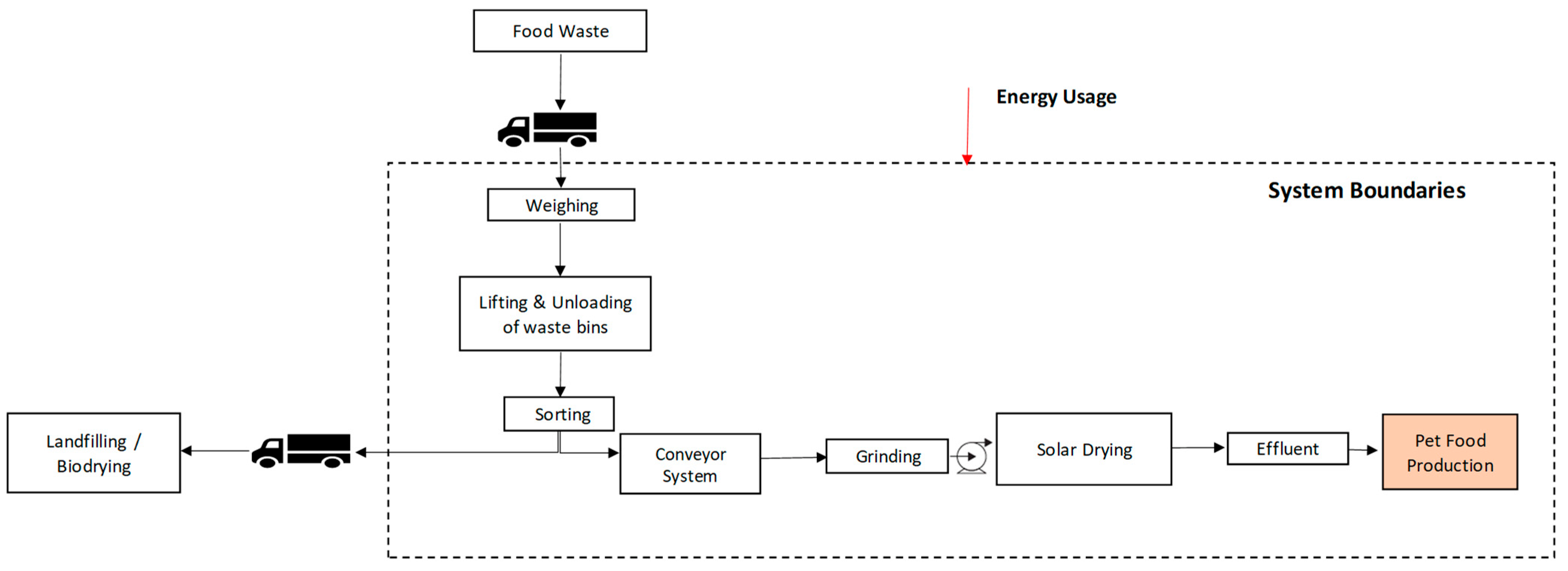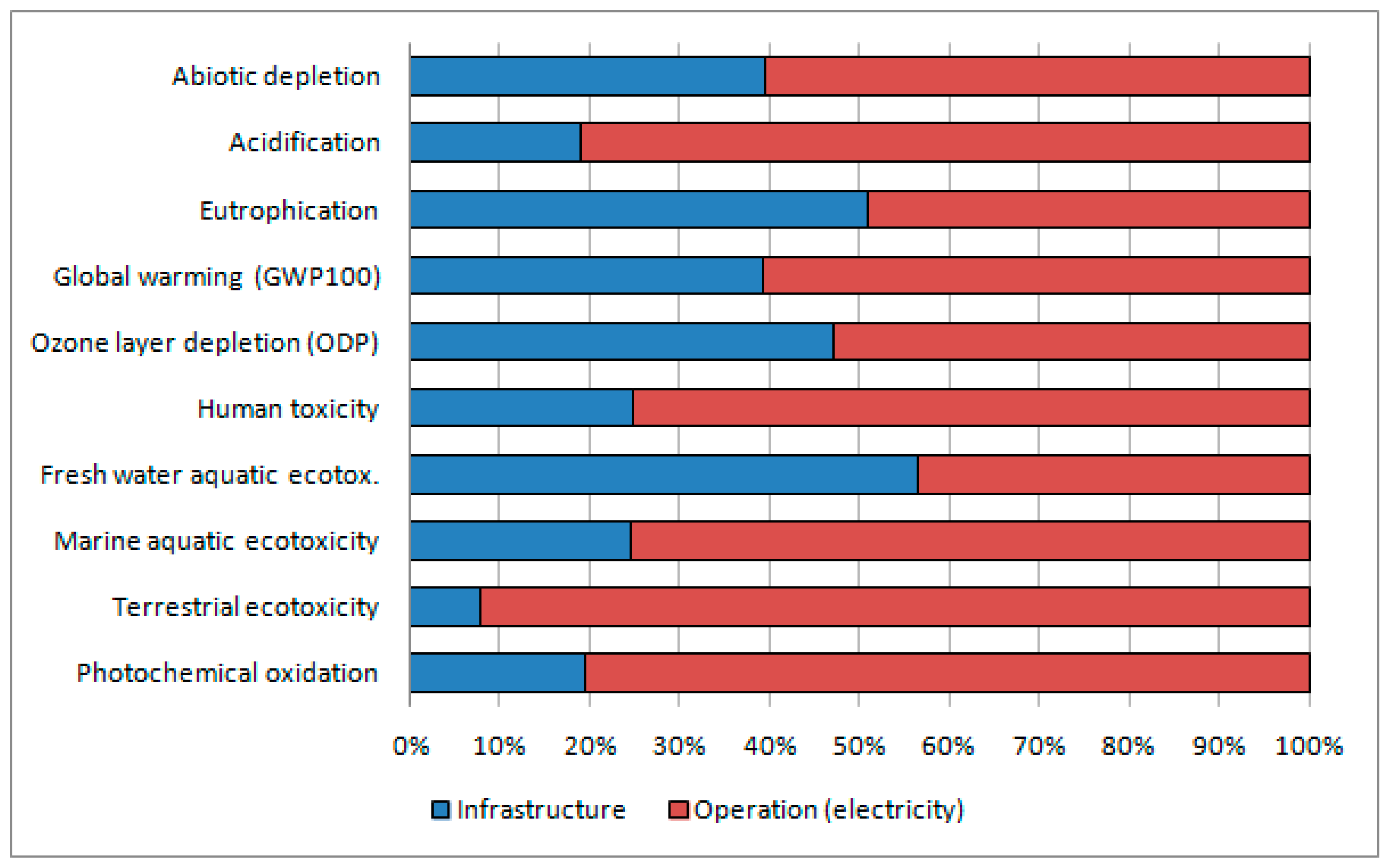Environmental Impact Assessment of a Solar Drying Unit for the Transformation of Food Waste into Animal Feed
Abstract
1. Introduction
2. Materials and Methods
2.1. Goal and Scope Definition
2.2. Functional Unit
2.3. Life Cycle Inventory
- materials (e.g., reinforced concrete and asphalt) and operations (e.g., excavation) for landscaping and floor construction,
- metallic structures (pre-sorting unit and solar drying greenhouse),
- water supply and drainage infrastructure (e.g., excavation and pipes),
- electrical infrastructure (e.g., cables).

2.4. Life Cycle Impact Assessment
3. Results
4. Discussion
5. Conclusions
Author Contributions
Funding
Data Availability Statement
Conflicts of Interest
References
- Truong, L.; Morash, D.; Liu, Y.; King, A. Food waste in animal feed with a focus on use for broilers. Int. J. Recycl. Org. Waste Agric. 2019, 8, 417–429. [Google Scholar] [CrossRef]
- Ec.europa.eu. Directive 2008/98/EC on Waste (Waste Framework Directive)—Environment—European Commission. 2018. Available online: https://eur-lex.europa.eu/legal-content/EN/TXT/?uri=CELEX:32008L0098 (accessed on 15 October 2022).
- Communication from the Commission to the European Parliament, the Council, the European Economic and Social Committee and the Committee of the Regions a Sustainable Bioeconomy for Europe: Strengthening the Connection between Economy, Society and the Environment. Available online: https://eur-lex.europa.eu/legal-content/EN/TXT/?uri=CELEX%3A52018DC0673 (accessed on 30 November 2022).
- European Commission. Food Safety, Food Waste Measurement. Available online: https://food.ec.europa.eu/safety/food-waste/eu-actions-against-food-waste/food-waste-measurement_en (accessed on 30 November 2022).
- Tsai, W.-T. Turning Food Waste into Value-Added Resources: Current Status and Regulatory Promotion in Taiwan. Resources 2020, 9, 53. [Google Scholar] [CrossRef]
- Dou, Z.; Toth, J.D.; Westendorf, M.L. Food waste for livestock feeding: Feasibility, safety, and sustainability implications. Glob. Food Secur. 2018, 17, 154–161. [Google Scholar] [CrossRef]
- Georganas, A.; Giamouri, E.; Pappas, A.C.; Papadomichelakis, G.; Galliou, F.; Manios, T.; Tsiplakou, E.; Fegeros, K.; Zervas, G. Bioactive Compounds in Food Waste: A Review on the Transformation of Food Waste to Animal Feed. Foods 2020, 9, 291. [Google Scholar] [CrossRef] [PubMed]
- Paßlack, N.; Galliou, F.; Manios, T.; Papadaki, A.; Markakis, N.; Sambathianakis, I.; Lasaridi, K.; Fortatos, S.; Kyriacou, A.; Vahjen, W.; et al. Investigations on the Use of Dried Food Residues as a Potential Dietary Ingredient for Cats. Sustainability 2021, 13, 11603. [Google Scholar] [CrossRef]
- Shurson, G.C. “What a Waste”—Can We Improve Sustainability of Food Animal Production Systems by Recycling Food Waste Streams into Animal Feed in an Era of Health, Climate, and Economic Crises? Sustainability 2020, 12, 7071. [Google Scholar] [CrossRef]
- Commission Notice, Guidelines for the Feed Use of Food No Longer Intended for Human Consumption (2018/C 133/02). Available online: https://circulareconomy.europa.eu/platform/sites/default/files/feed_guidelines.pdf (accessed on 15 October 2022).
- Castrica, M.; Tedesco, D.E.A.; Panseri, S.; Ferrazzi, G.; Ventura, V.; Frisio, D.G.; Balzaretti, C.M. Pet Food as the Most Concrete Strategy for Using Food Waste as Feedstuff within the European Context: A Feasibility Study. Sustainability 2018, 10, 2035. [Google Scholar] [CrossRef]
- Giamouri, E.; Pappas, A.C.; Papadomichelakis, G.; Simitzis, P.E.; Manios, T.; Zentek, J.; Lasaridi, K.; Tsiplakou, E.; Zervas, G. The Food for Feed Concept: Redefining the Use of Hotel Food Residues in Broiler Diets. Sustainability 2022, 14, 3659. [Google Scholar] [CrossRef]
- Nijmeh, M.N.; Ragab, A.S.; Emeish, M.S.; Jubran, B.A. Design and testing of solar dryers for processing food wastes. Appl. Therm. Eng. 1998, 18, 1337–1346. [Google Scholar] [CrossRef]
- Noori, A.W.; Royen, M.J.; Medved’ová, A.; Haydary, J. Drying of Food Waste for Potential Use as Animal Feed. Sustainability 2022, 14, 5849. [Google Scholar] [CrossRef]
- Lingayat, A.; Balijepalli, R.; Chandramohan, V.P. Applications of solar energy based drying technologies in various industries—A review. Sol. Energy 2021, 229, 52–68. [Google Scholar] [CrossRef]
- Pennington, D.W.; Potting, J.; Finnveden, G.; Lindeijer, E.; Jolliet, O.; Rydberg, T.; Rebitzer, G. A Life cycle assessment: Part 2: Current impact assessment practice. Environ. Int. 2004, 30, 721–739. [Google Scholar] [CrossRef] [PubMed]
- Ominski, K.; McAllister, T.S.; Kim, M.; Genet Kebebe, E.G.; Omonijo, F.; Cordeiro, M.; Legesse, G.; Wittenberg, K. Utilization of by-products and food waste in livestock production systems: A Canadian perspective. Anim. Fron. 2021, 11, 55–63. [Google Scholar] [CrossRef] [PubMed]
- Ferguson, J.D. Food Residue, Loss and Waste as Animal Feed. In Encyclopedia of Renewable and Sustainable Materials; Hashmi, S., Choudhury, I.A., Eds.; Elsevier: Amsterdam, The Netherlands, 2020; pp. 395–407. ISBN 9780128131961. [Google Scholar] [CrossRef]
- Ecoinvent. 2022. Available online: https://ecoinvent.org (accessed on 15 October 2022).
- Guinee, J. Handbook on Life Cycle Assessment. An Operational Guide to the ISO Standards. Int. J. Life Cycle Assess. 2001, 7, 311–313. [Google Scholar] [CrossRef]
- Bernstad, A.; la Cour Jansen, J. Review of comparative LCAs of food waste management systems—Current status and potential improvements. Waste Manag. 2012, 32, 2439–2455. [Google Scholar] [CrossRef] [PubMed]
- The Life + Food4Feed Project, Deliverable B4.1 “Complete Chemical Analysis of the Produced Feed, through the Pigs and Poultry Husbandry Perspective”. Available online: https://life-f4f.gr/wp-content/uploads/2022/02/deliverable-b4.1.pdf (accessed on 15 October 2022).
- The Life + Food4Feed Project, Deliverable B4.3 “Economic Evaluation of the Produced Feed, Regarding Pigs and Poultry Husbandry”. Available online: https://life-f4f.gr/wp-content/uploads/2022/02/deliverable-b4.3.pdf (accessed on 15 October 2022).
- Mosna, D.; Bottani, E.; Vignali, G.; Montanari, R. Environmental benefits of pet food obtained as a result of the valorisation of meat fraction derived from packaged food waste. Waste Manag. 2021, 125, 132–144. [Google Scholar] [CrossRef] [PubMed]
- Musmarra, D.; Zafeirakou, A.; Manakou, V.; Emmanouil, C. Efficient and Sustainable Environmental Management as a Means of Addressing Current Pollution Issues. Environ. Sci. Pollut. Res. 2019, 26, 14703–14705. [Google Scholar] [CrossRef] [PubMed]
- Nakaishi, T.; Takayabu, H. Production efficiency of animal feed obtained from food waste in Japan. Environ. Sci. Pollut. Res. 2022, 29, 61187–61203. [Google Scholar] [CrossRef] [PubMed]
- Kim, M.-H.; Kim, J.-W. Comparison through an LCA evaluation analysis of food waste disposal options from the perspective of global warming and resource recovery. Sci. Total Environ. 2010, 408, 3998–4006. [Google Scholar] [CrossRef] [PubMed]
- zu Ermgassen, E.K.H.J.; Phalan, B.; Green, R.E.; Balmford, A. Reducing the land use of EU pork production: Where there’s swill, there’s a way. Food Policy 2016, 58, 35–48. [Google Scholar] [CrossRef] [PubMed]



| Infrastructure Material/Process | Measure | Unit |
|---|---|---|
| Landscaping | ||
| Excavation, hydraulic digger | 129.3 | m3 |
| Floor construction | ||
| Aerated concrete block, reinforced | 271,780 | kg |
| Lightweight concrete block | 31,200 | kg |
| Epoxy resin insulator (Al2O3) | 18,648 | kg |
| Gravel, crushed | 800 | kg |
| Bitumen sealing Alu80 | 14,853 | kg |
| Excavation, hydraulic digger | 0.8 | m3 |
| Electrical cabling | ||
| PVC pipe | 62.2 | kg |
| Copper wire | 29.8 | kg |
| Water supply | ||
| Cast iron | 10 | kg |
| HDPE pipes | 21.7 | kg |
| Drainage | ||
| Cast iron | 20 | kg |
| HDPE pipes | 55 | kg |
| PVC pipe | 17 | kg |
| Excavation, hydraulic digger | 5 | m3 |
| Metallic structures | ||
| Stainless steel | 580 | kg |
| Polyurethane rigid foam | 12.8 | kg |
| Polycarbonate | 1112 | kg |
| Electricity consumption (operation for 126 d) | 28,882 | KWh |
| Heat pump | ||
| Stainless steel | 74.3 | kg |
| Copper tube | 17.44 | kg |
| Lubricant oil | 0.4 | L |
| PVC pipe | 0.2 | kg |
| HDPE pipes | 4 | kg |
| Acrylonitrile–butadiene–styrene copolymer | 0.5 | kg |
| Refrigerant R134a | 1.35 | kg |
| Cast iron | 1.5 | kg |
| Brass | 0.23 | kg |
| Solar collectors | ||
| Solar glass, low-iron | 84 | kg |
| Copper tube | 37.1 | kg |
| Aluminum sheet | 77 | kg |
| Impact Category | Unit | Total | Landscaping | Floor Construction | Electrical Cabling | Drainage | Metallic Structure | Pumps | Solar Collector | Water Supply | Heat Pump |
|---|---|---|---|---|---|---|---|---|---|---|---|
| Abiotic depletion | kg Sb eq | 0.53 | 0.00 | 0.50 | 0.00 | 0.00 | 0.02 | 0.00 | 0.00 | 0.00 | 0.00 |
| Acidification | kg SO2 eq | 0.30 | 0.00 | 0.28 | 0.00 | 0.00 | 0.01 | 0.00 | 0.00 | 0.00 | 0.00 |
| Eutrophication | kg PO4− eq | 0.06 | 0.00 | 0.06 | 0.00 | 0.00 | 0.00 | 0.00 | 0.00 | 0.00 | 0.00 |
| Global warming (GWP100) | kg CO2 eq | 85.43 | 0.03 | 81.02 | 0.08 | 0.08 | 3.66 | 0.00 | 0.26 | 0.03 | 0.29 |
| Ozone layer depletion (ODP) | kg CFC-11 eq | 0.00 | 0.00 | 0.00 | 0.00 | 0.00 | 0.00 | 0.00 | 0.00 | 0.00 | 0.00 |
| Human toxicity | kg 1,4-DB eq | 30.32 | 0.02 | 29.50 | 0.14 | 0.06 | 0.40 | 0.00 | 0.10 | 0.01 | 0.09 |
| Freshwater aquatic ecotoxicity | kg 1,4-DB eq | 16.02 | 0.00 | 15.90 | 0.02 | 0.02 | 0.05 | 0.00 | 0.01 | 0.01 | 0.01 |
| Marine aquatic ecotoxicity | kg 1,4-DB eq | 20,917.69 | 4.18 | 20,773.36 | 0.00 | 12.55 | 71.12 | 0.00 | 23.01 | 6.28 | 27.19 |
| Terrestrial ecotoxicity | kg 1,4-DB eq | 0.24 | 0.00 | 0.23 | 0.00 | 0.00 | 0.01 | 0.00 | 0.00 | 0.00 | 0.00 |
| Photochemical oxidation | kg C2H4 eq | 0.01 | 0.00 | 0.01 | 0.00 | 0.00 | 0.00 | 0.00 | 0.00 | 0.00 | 0.00 |
| Impact Category | Unit | Landscaping | Floor Construction | Electrical Cabling | Drainage | Metallic Structure | Pumps | Solar Collector | Water Supply | Heat Pump |
|---|---|---|---|---|---|---|---|---|---|---|
| Abiotic depletion | % | 0.03 | 94.91 | 0.13 | 0.20 | 4.19 | 0.00 | 0.28 | 0.07 | 0.18 |
| Acidification | % | 0.06 | 94.23 | 0.12 | 0.11 | 4.54 | 0.00 | 0.51 | 0.03 | 0.41 |
| Eutrophication | % | 0.08 | 97.32 | 0.05 | 0.07 | 2.04 | 0.00 | 0.22 | 0.03 | 0.19 |
| Global warming (GWP100) | % | 0.03 | 94.84 | 0.09 | 0.09 | 4.28 | 0.00 | 0.30 | 0.03 | 0.34 |
| Ozone layer depletion (ODP) | % | 0.02 | 35.98 | 0.01 | 0.00 | 0.01 | 0.01 | 0.20 | 0.00 | 63.76 |
| Human toxicity | % | 0.05 | 97.30 | 0.45 | 0.21 | 1.33 | 0.00 | 0.32 | 0.04 | 0.31 |
| Freshwater aquatic ecotoxicity | % | 0.01 | 99.23 | 0.15 | 0.12 | 0.34 | 0.00 | 0.04 | 0.04 | 0.06 |
| Marine aquatic ecotoxicity | % | 0.02 | 99.31 | 0.00 | 0.06 | 0.34 | 0.00 | 0.11 | 0.03 | 0.13 |
| Terrestrial ecotoxicity | % | 0.01 | 94.48 | 0.09 | 0.22 | 4.73 | 0.00 | 0.21 | 0.10 | 0.16 |
| Photochemical oxidation | % | 0.04 | 93.52 | 0.13 | 0.19 | 5.21 | 0.00 | 0.44 | 0.07 | 0.42 |
| Impact Category | Unit | Infrastructure | Operation (Electricity) | Total | Total per Ton |
|---|---|---|---|---|---|
| Abiotic depletion | kg Sb eq | 75.93 | 116.05 | 191.98 | 1.33 |
| Acidification | kg SO2 eq | 42.63 | 183.00 | 225.63 | 1.57 |
| Eutrophication | kg PO4− eq | 8.09 | 7.78 | 15.87 | 0.11 |
| Global warming (GWP100) | kg CO2 eq | 12,302.43 | 19,010.22 | 31,312.65 | 217.45 |
| Ozone layer depletion (ODP) | kg CFC-11 eq | 0.002 | 0.00 | 0.00 | 0.00 |
| Human toxicity | kg 1,4-DB eq | 4365.38 | 13,309.08 | 17,674.46 | 122.74 |
| Freshwater aquatic ecotoxicity | kg 1,4-DB eq | 2306.26 | 1777.36 | 4083.61 | 28.36 |
| Marine aquatic ecotoxicity | kg 1,4-DB eq | 3,012,147.54 | 9,231,673.00 | 12,243,820.54 | 85,026.53 |
| Terrestrial ecotoxicity | kg 1,4-DB eq | 34.36 | 404.83 | 439.19 | 3.05 |
| Photochemical oxidation | kg C2H4 eq | 1.95 | 8.02 | 9.97 | 0.07 |
| Description | Units | Result |
|---|---|---|
| Water in: 144 t ∗ 75% humidity | t of water | 108 |
| Water out: 30 t ∗ 12% | t of water | 3.6 |
| Water evaporated | t of water | 104.4 (i.e., 108–3.6) |
| Total energy required for evaporation * | MJ | 254,913.48 |
| Low sulfur diesel avoided by solar heating ** | t of low-sulfur diesel | 5984 |
Publisher’s Note: MDPI stays neutral with regard to jurisdictional claims in published maps and institutional affiliations. |
© 2022 by the authors. Licensee MDPI, Basel, Switzerland. This article is an open access article distributed under the terms and conditions of the Creative Commons Attribution (CC BY) license (https://creativecommons.org/licenses/by/4.0/).
Share and Cite
Abeliotis, K.; Chroni, C.; Lasaridi, K.; Terzis, E.; Galliou, F.; Manios, T. Environmental Impact Assessment of a Solar Drying Unit for the Transformation of Food Waste into Animal Feed. Resources 2022, 11, 117. https://doi.org/10.3390/resources11120117
Abeliotis K, Chroni C, Lasaridi K, Terzis E, Galliou F, Manios T. Environmental Impact Assessment of a Solar Drying Unit for the Transformation of Food Waste into Animal Feed. Resources. 2022; 11(12):117. https://doi.org/10.3390/resources11120117
Chicago/Turabian StyleAbeliotis, Konstadinos, Christina Chroni, Katia Lasaridi, Evangelos Terzis, Fenia Galliou, and Thrassyvoulos Manios. 2022. "Environmental Impact Assessment of a Solar Drying Unit for the Transformation of Food Waste into Animal Feed" Resources 11, no. 12: 117. https://doi.org/10.3390/resources11120117
APA StyleAbeliotis, K., Chroni, C., Lasaridi, K., Terzis, E., Galliou, F., & Manios, T. (2022). Environmental Impact Assessment of a Solar Drying Unit for the Transformation of Food Waste into Animal Feed. Resources, 11(12), 117. https://doi.org/10.3390/resources11120117








